The global horizontal premade pouch packing machine market is projected to grow from USD 364.3 million in 2025 to approximately USD 555 million by 2035, recording an absolute increase of USD 190.7 million over the forecast period. This translates into a total growth of 52.3%, with the market forecast to expand at a compound annual growth rate (CAGR) of 4.3% between 2025 and 2035. The overall market size is expected to grow by 1.5X during the same period, supported by accelerating demand for flexible packaging solutions in food processing applications, breakthrough advancements in automated packing technologies, and expanding adoption of premade pouch formats across pharmaceutical and cosmetic manufacturing facilities.
The steady market expansion reflects the transformative potential of horizontal premade pouch packing technology in revolutionizing packaging operations and production efficiency systems. Major food processing companies worldwide are increasingly incorporating advanced automated packing solutions to enhance operational productivity and reduce material waste from conventional packaging methods, while breakthrough developments in pharmaceutical manufacturing and cosmetic production are creating unprecedented demand for specialized machines that deliver superior speed characteristics and operational reliability under strict hygiene conditions.

Manufacturing capabilities are advancing rapidly as leading producers invest in precision automation facilities and proprietary servo control technologies to meet growing market demand for enhanced packaging speeds and reduced changeover times. The technology landscape continues evolving with innovations in pouch handling mechanisms, sealing system design, and control software integration that enhance packaging performance while reducing maintenance requirements. Packaging equipment manufacturers and automation specialists are collaborating extensively to develop next-generation packing machine products that address specific requirements across food processing systems, pharmaceutical packaging lines, and cosmetic manufacturing sectors.
Quality standards are becoming increasingly stringent as applications demand higher packaging specifications and greater reliability under continuous production conditions. Industry certification programs and validation protocols ensure consistent machine performance while supporting market confidence in automated packaging technology adoption across regulated manufacturing environments and food safety applications. Regulatory compliance requirements for pharmaceutical and food applications are driving investments in comprehensive quality management systems and testing protocols throughout the manufacturing supply chain.
International collaboration is accelerating market development as major packaging projects require coordinated efforts between multiple equipment manufacturers and system integration suppliers. Global manufacturing companies are establishing standardized specifications for packing machine performance that influence worldwide manufacturing standards and create opportunities for specialized suppliers. Packaging system engineering firms are forming strategic partnerships with machine manufacturers to develop application-specific solutions tailored to emerging production technologies and facility requirements.
Investment patterns are shifting toward integrated solution development as major end-users seek comprehensive packaging systems that combine packing machines with advanced monitoring capabilities and predictive maintenance features. Manufacturing companies are forming joint ventures with technology providers to develop customized packaging platforms, while food processing developers are acquiring stakes in specialized machine manufacturers to ensure access to cutting-edge packaging technologies for their production and maintenance programs. This trend toward strategic partnerships and technology integration is reshaping competitive dynamics across the packaging automation value chain.
Market maturation is evident in the emergence of specialized application segments that demand unique machine characteristics and performance specifications. Food processing applications require extremely stable packaging performance and sanitary design under continuous production conditions, while pharmaceutical systems need packing machines that maintain accuracy and reliability when handling sterile packaging materials and validation requirements. These specialized requirements are driving innovation in machine materials, control technologies, and packaging methodologies that extend beyond traditional consumer goods and industrial packaging applications.
| Metric | Value |
|---|---|
| Market Value (2025) | USD 364.3 million |
| Market Forecast Value (2035) | USD 555 million |
| Forecast CAGR (2025 to 2035) | 4.3% |
| FOOD PROCESSING AUTOMATION | PHARMACEUTICAL MODERNIZATION | PACKAGING EFFICIENCY DEMANDS |
|---|---|---|
| Consumer Goods Expansion - Food manufacturers upgrading to automated packaging systems and flexible pouch formats requiring precision horizontal machines for snack foods, ready meals, and beverage pouches with enhanced speed capabilities and consistent sealing quality under high-volume production conditions. | Sterile Packaging Requirements - Pharmaceutical facilities implementing automated pouch packing for medical devices, oral medications, and sterile products requiring precision machines for unit dose packaging, clinical trial materials, and regulatory compliance with superior contamination prevention capabilities. | Production Efficiency Enhancement - Manufacturing facilities implementing automated packaging solutions and lean production systems requiring sophisticated horizontal machines for reduced labor costs, improved throughput rates, and minimized packaging material waste with exceptional operational reliability. |
| Fresh Food Packaging - Produce processing and fresh food manufacturers requiring specialized horizontal packing solutions for modified atmosphere packaging, extended shelf-life applications, and retail-ready formats with superior barrier properties and temperature control during packaging operations. | Medical Device Packaging - Healthcare product manufacturers implementing advanced packaging systems requiring horizontal machines for surgical instruments, diagnostic equipment, and implantable devices with enhanced sterility maintenance and traceability features. | Labor Cost Management - Food processing and manufacturing facilities reducing manual labor requirements through automated packaging systems requiring horizontal machines for consistent operation, reduced training needs, and improved workplace safety with minimal operator intervention. |
| E-commerce Packaging - Online retail and direct-to-consumer brands requiring flexible packaging solutions for shipping applications, portion control products, and subscription services with specialized horizontal machines for varied pouch sizes and enhanced protection characteristics. | Nutraceutical Growth - Supplement and health product manufacturers implementing precise packaging systems requiring horizontal machines for powdered products, capsule packaging, and specialized dosage forms with accurate filling and superior moisture protection. | Quality Consistency - Manufacturing operations requiring standardized packaging quality and reduced variability through automated systems with horizontal machines providing consistent sealing temperatures, precise positioning, and repeatable packaging results across production batches. |
| Category | Segments / Values |
|---|---|
| By Type | Single Station; Multiple Station; Rotary Type; Linear Type; Others |
| By Application | Food; Medicine; Cosmetic; Chemical; Others |
| By End-User | Food Processing Companies; Pharmaceutical Manufacturers; Cosmetic Producers; Chemical Companies; Others |
| By Pouch Type | Stand-up Pouches; Flat Pouches; Spouted Pouches; Zipper Pouches; Others |
| By Distribution Channel | Direct Sales; Equipment Distributors; Online Platforms; System Integrators |
| By Region | North America; Europe; Asia Pacific; Latin America; Middle East & Africa |
.webp)
| Segment | 2025 to 2035 Outlook |
|---|---|
| Multiple Station | Leader in 2025 with 67.3% market share; optimal productivity and versatility for high-volume manufacturing applications. Widely adopted for food processing and pharmaceutical packaging requiring multiple packaging operations. Momentum: strong growth across food processing and pharmaceutical segments. Watchouts: higher complexity and maintenance requirements compared to single station systems. |
| Single Station | Significant segment with 32.7% share, favored for smaller production volumes and specialized applications requiring flexible changeover capabilities and compact footprint installations. Momentum: steady growth in cosmetic and specialty food applications. Watchouts: limited throughput capacity for high-volume production requirements. |
| Rotary Type | Specialized segment offering continuous motion capabilities for ultra-high speed applications in major food processing operations. Momentum: growing adoption in large-scale consumer goods manufacturing. Watchouts: higher investment costs and technical complexity. |
| Linear Type | Established segment providing reliable performance for diverse packaging applications with straightforward maintenance procedures. Momentum: consistent demand across multiple industry sectors. |
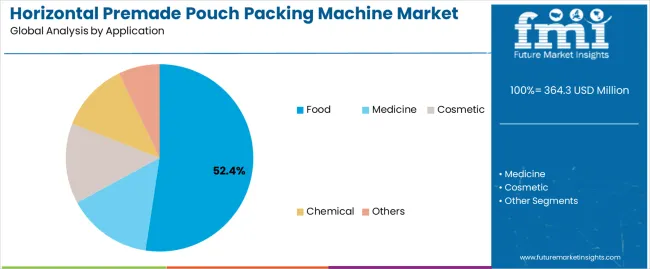
| Segment | 2025 to 2035 Outlook |
|---|---|
| Food | Largest application segment in 2025 at 52.4% share, driven by consumer goods packaging and fresh food processing requiring automated solutions for snack foods, ready meals, and beverage applications. Includes frozen foods, dairy products, and confectionery packaging. Momentum: robust growth from e-commerce packaging and convenience food expansion. Watchouts: food safety compliance and sanitary design requirements. |
| Medicine | Critical segment representing 28.9% share, experiencing strong growth from pharmaceutical manufacturing and medical device packaging requiring sterile processing capabilities. Momentum: exceptional growth as pharmaceutical companies adopt automated packaging technologies. Watchouts: regulatory validation requirements and sterility maintenance complexity. |
| Cosmetic | Growing segment at 12.8% share for personal care products, beauty items, and toiletry packaging requiring attractive presentation and product protection systems. Momentum: strong growth from premium cosmetic brands and sustainable packaging trends. Watchouts: aesthetic requirements and product compatibility considerations. |
| Others | Includes chemical products, pet food, and industrial applications. Momentum: diverse growth opportunities across multiple specialized sectors. |
| Distribution Channel | Status & Outlook (2025-2035) |
|---|---|
| Direct Sales | Dominant channel in 2025 with 71.8% share for specialized manufacturing applications. Provides technical consultation, application engineering, and customized solutions for complex packaging projects. Momentum: strong growth driven by food processing automation and pharmaceutical packaging requiring direct manufacturer engagement. Watchouts: resource constraints and technical support capacity limitations. |
| Equipment Distributors | Technical distribution serving packaging contractors and system integrators with comprehensive product portfolios and local service capabilities. Momentum: moderate growth as market expands beyond core food processing applications. Watchouts: inventory investment requirements and technical training needs. |
| Online Platforms | Digital channel for standard machine configurations and replacement components serving smaller manufacturers and maintenance facilities. Momentum: growing importance as buyers seek convenient procurement and competitive pricing. |
| System Integrators | Collaborative channel for complete packaging line projects with engineering firms and automation specialists. Momentum: strategic growth as manufacturing automation and integrated packaging systems accelerate. |
| DRIVERS | RESTRAINTS | KEY TRENDS |
|---|---|---|
| Food Processing Growth across consumer goods manufacturing and fresh food packaging creating substantial demand for specialized horizontal packing machines supporting flexible pouch formats, modified atmosphere packaging, and high-speed production systems. | High Capital Investment and complex system integration requirements limit accessibility across smaller food processors and specialized manufacturers with limited automation budgets. | Smart Packaging Integration - Advanced horizontal machines incorporating monitoring capabilities, diagnostic features, and remote communication systems for predictive maintenance and production optimization. |
| Pharmaceutical Automation Expansion - Medical device manufacturing and pharmaceutical production upgrades driving adoption of precision packing machines for sterile packaging, unit dose applications, and regulatory compliance systems. | Technical Complexity - Installation requirements, validation procedures, and specialized maintenance protocols affect deployment timelines and operational capabilities for facilities lacking dedicated packaging engineering resources. | Flexibility Enhancement - Innovations in servo control technology, quick changeover systems, and modular design delivering improved versatility with enhanced production capability and reduced setup times. |
| Labor Cost Pressures - Manufacturing facility automation and workforce optimization requiring robust packaging machines for reduced manual handling, improved consistency, and enhanced workplace safety with superior operational reliability. | Maintenance Requirements - Specialized service needs and replacement part availability constrain adoption among manufacturers lacking dedicated maintenance teams and technical support resources. | Hygiene Design Advancement - Sanitary construction features, easy cleaning protocols, and contamination prevention systems meeting food safety and pharmaceutical regulatory requirements. |
| Packaging Innovation - Consumer demand for convenient packaging formats and extended shelf-life products driving adoption of flexible pouch solutions with horizontal machines providing superior sealing performance and material handling capabilities. | Regulatory Compliance - Validation requirements and documentation procedures create operational complexity and ongoing costs for pharmaceutical and food manufacturing facilities. | Energy Efficiency Focus - Integration with facility management systems, optimized power consumption, and reduced environmental impact through advanced motor control and operational monitoring capabilities. |
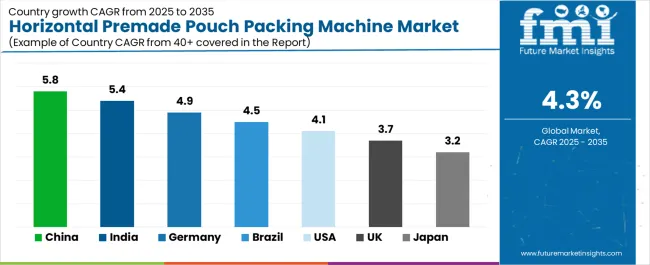
| Country | CAGR (2025-2035) |
|---|---|
| China | 5.8% |
| India | 5.4% |
| Germany | 4.9% |
| Brazil | 4.5% |
| United States | 4.1% |
| United Kingdom | 3.7% |
| Japan | 3.2% |
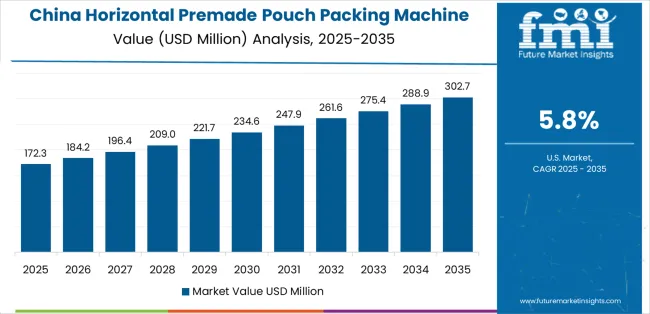
Revenue from horizontal premade pouch packing machine in China is projected to exhibit exceptional growth with a market value of USD 192.8 million by 2035, driven by massive food processing expansion and comprehensive manufacturing automation initiatives creating substantial opportunities for packaging technology suppliers across consumer goods production, pharmaceutical manufacturing, and export-oriented packaging sectors. The country's ambitious industrial development programs including national food safety initiatives and pharmaceutical manufacturing expansion are creating unprecedented demand for specialized automated packaging systems. Major manufacturing companies and food processing facilities including domestic producers and multinational operations are establishing comprehensive packaging automation programs to support large-scale consumer goods production and advanced manufacturing applications.
Revenue from horizontal premade pouch packing machine in India is expanding to reach USD 148.6 million by 2035, supported by extensive food processing development programs and comprehensive manufacturing infrastructure initiatives creating demand for packaging solutions across diverse consumer goods and pharmaceutical application segments. The country's growing food processing capabilities and expanding pharmaceutical manufacturing infrastructure are driving demand for packaging equipment that provides exceptional reliability while supporting advanced production requirements. Food processing companies and pharmaceutical facilities are investing in packaging technology development to support growing domestic demand and export manufacturing requirements.
Demand for horizontal premade pouch packing machine in Germany is projected to reach USD 118.3 million by 2035, supported by the country's leadership in packaging technology and advanced manufacturing systems requiring sophisticated packing machines for food processing and pharmaceutical applications. German manufacturing operators are implementing cutting-edge packaging platforms that support advanced automation capabilities, operational precision, and comprehensive performance monitoring protocols. The market is characterized by focus on engineering excellence, technology innovation, and compliance with stringent food safety and pharmaceutical standards.
Revenue from horizontal premade pouch packing machine in Brazil is growing to reach USD 104.7 million by 2035, driven by food processing infrastructure development programs and increasing manufacturing capabilities creating opportunities for packaging suppliers serving both consumer goods operations and specialized processing contractors. The country's expanding food processing sector and growing manufacturing infrastructure are creating demand for packaging equipment that supports diverse production requirements while maintaining performance standards. Food processors and manufacturing companies are developing technology strategies to support operational efficiency and production reliability advancement.
Demand for horizontal premade pouch packing machine in United States is projected to reach USD 126.4 million by 2035, expanding at a CAGR of 4.1%, driven by advanced food processing modernization and specialized manufacturing applications supporting consumer goods production and comprehensive packaging infrastructure applications. The country's established food processing tradition including major consumer goods companies and manufacturing facilities are creating demand for high-performance packaging equipment that supports operational advancement and safety standards. Manufacturers and packaging system suppliers are maintaining comprehensive development capabilities to support diverse food processing and manufacturing requirements.
Revenue from horizontal premade pouch packing machine in United Kingdom is growing to reach USD 89.2 million by 2035, supported by food processing heritage and established manufacturing communities driving demand for premium packaging solutions across traditional food systems and specialized consumer goods applications. The country's rich food processing heritage including major consumer goods companies and established manufacturing capabilities create demand for packaging equipment that supports both legacy system advancement and modern production applications.
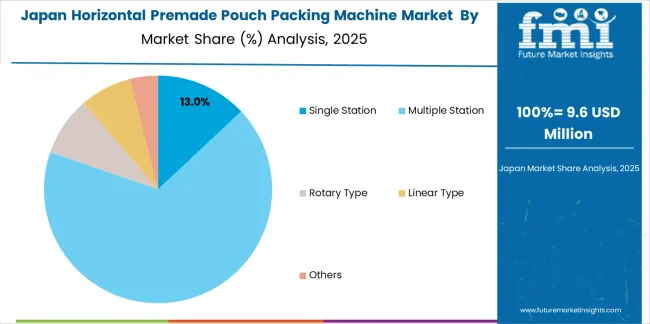
Demand for horizontal premade pouch packing machine in Japan is projected to reach USD 97.4 million by 2035, driven by precision packaging technology tradition and established manufacturing leadership supporting both domestic food processing markets and export-oriented equipment production. Japanese companies maintain sophisticated packaging development capabilities, with established manufacturers continuing to lead in packaging technology and food processing equipment standards.
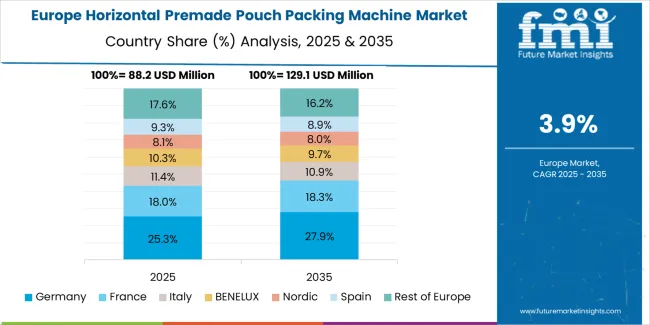
European horizontal premade pouch packing machine operations are increasingly concentrated between German engineering excellence and specialized manufacturing across multiple countries. German facilities dominate high-performance machine production for food processing and pharmaceutical applications, leveraging cutting-edge automation technologies and strict quality protocols that command price premiums in global markets. British food processing operators maintain leadership in packaging innovation and production method development, with organizations like major consumer goods companies and research centers driving technical specifications that suppliers must meet to access major processing contracts.
Eastern European operations in Czech Republic and Poland are capturing specialized production contracts through precision manufacturing expertise and EU compliance standards, particularly in equipment fabrication and assembly technologies for food processing applications. These facilities increasingly serve as development partners for Western European processing programs while building their own packaging technology expertise.
The regulatory environment presents both opportunities and constraints. European food safety framework requirements create quality standards that favor established European manufacturers and food processing operators while ensuring consistent performance specifications for consumer goods and pharmaceutical applications. Brexit has created complexity for UK processing collaboration with EU programs, driving opportunities for direct relationships between British operators and international packaging suppliers.
Technology collaboration accelerates as processors seek packaging advancement to support major food safety milestones and automation timelines. Vertical integration increases, with major food processing operators acquiring specialized manufacturing capabilities to secure equipment supplies and quality control for consumer goods programs. Smaller processing contractors face pressure to specialize in niche applications or risk displacement by larger, more comprehensive operations serving mainstream food processing and manufacturing requirements.
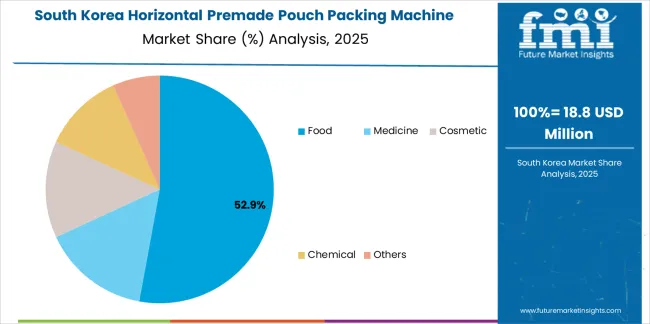
South Korean horizontal premade pouch packing machine operations reflect the country's advanced food processing infrastructure capabilities and export-oriented technology development model. Major food processing operators including domestic consumer goods companies and manufacturing facilities drive equipment procurement strategies for their packaging facilities, establishing direct relationships with specialized packaging suppliers to secure consistent quality and performance for their production programs and advanced manufacturing systems targeting both domestic processing and international collaboration projects.
The Korean market demonstrates particular strength in integrating horizontal packing technologies into automated production platforms and advanced manufacturing configurations, with engineering teams developing solutions that bridge traditional food processing applications and next-generation packaging systems. This integration approach creates demand for specific performance specifications that differ from conventional applications, requiring suppliers to adapt packaging capabilities and system coordination characteristics.
Regulatory frameworks emphasize food safety and production system reliability, with Korean food processing standards often exceeding international requirements for packaging systems. This creates barriers for standard equipment suppliers but benefits established manufacturers who can demonstrate food-grade performance capabilities. The regulatory environment particularly favors suppliers with Korean processing system qualification and comprehensive testing documentation systems.
Supply chain excellence remains critical given Korea's manufacturing focus and international collaboration dynamics. Food processing operators increasingly pursue development partnerships with suppliers in Japan, Germany, and specialized manufacturers to ensure access to cutting-edge packaging technologies while managing production risks. Investment in processing infrastructure supports performance advancement during extended manufacturing development cycles.
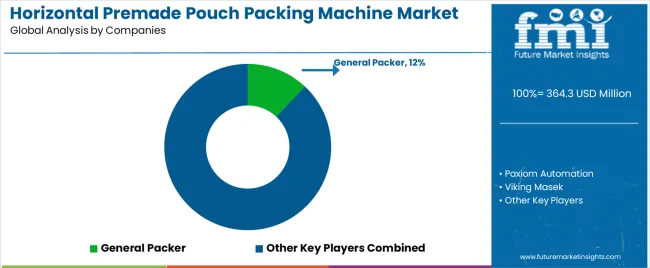
Profit pools are consolidating upstream in advanced machine manufacturing and downstream in application-specific solutions for food processing, pharmaceutical packaging, and consumer goods markets where packaging performance, reliability, and exceptional speed capabilities command substantial premiums.
Value is migrating from basic machine production to specification-driven, application-ready packaging systems where automation engineering expertise, precision manufacturing, and reliable performance characteristics create competitive advantages. Several archetypes define market leadership: established American manufacturers defending share through advanced packaging technology and comprehensive application support; German precision equipment companies leveraging manufacturing excellence and engineering capabilities; Japanese packaging leaders with food processing expertise and precision manufacturing heritage; and emerging manufacturers pursuing cost-effective production while developing advanced packaging capabilities.
Switching costs - system integration, application validation, performance qualification - provide stability for established suppliers, while technological advancement requirements and food processing application growth create opportunities for innovative manufacturers.
Consolidation continues as companies seek manufacturing scale; direct food processor partnerships grow for specialized applications while traditional equipment distribution remains relationship-driven. Focus areas: secure food processing and pharmaceutical packaging market positions with application-specific performance specifications and technical collaboration; develop packaging technology and advanced manufacturing capabilities; explore specialized applications including e-commerce packaging and pharmaceutical requirements.
| Stakeholder Type | Primary Advantage | Repeatable Plays |
|---|---|---|
| American Technology Leaders | Advanced packaging expertise; proven reliability; established food processor relationships | Precision manufacturing; technical innovation; application support |
| German Engineering Companies | Manufacturing excellence; comprehensive development programs; established customer partnerships | Engineering collaboration focus; integrated solutions; technical consultation |
| Japanese Packaging Leaders | Food processing expertise; precision technology leadership; trusted by major processing programs | Processing partnerships; application-specific specifications; manufacturing collaboration |
| Emerging Technology Producers | Manufacturing efficiency; competitive pricing; rapid technology development | Production scaling; technology advancement; market entry strategies |
| Equipment Distributors | Technical distribution networks; contractor relationships | Packaging expertise; inventory management; technical support services |
| Item | Value |
|---|---|
| Quantitative Units | USD 364.3 million |
| Type Segments | Single Station; Multiple Station; Rotary Type; Linear Type; Others |
| Applications | Food; Medicine; Cosmetic; Chemical; Others |
| End-Users | Food Processing Companies; Pharmaceutical Manufacturers; Cosmetic Producers; Chemical Companies; Others |
| Pouch Type Segments | Stand-up Pouches; Flat Pouches; Spouted Pouches; Zipper Pouches; Others |
| Distribution Channels | Direct Sales; Equipment Distributors; Online Platforms; System Integrators |
| Regions Covered | North America; Latin America; Europe; Asia Pacific; Middle East & Africa |
| Key Countries | China; India; Germany; Brazil; United States; United Kingdom; Japan (+35 additional countries) |
| Key Companies Profiled | General Packer; Paxiom Automation; Viking Masek; LENIS MACHINES; Mespack; Topack; Echo Machinery; MAKWELL MACHINERY CO.,LTD.; Hualian Pharmaceutical Machinery Technology; Foshan Land Packaging Machinery; ZHEJIANG GUCHUAN MACHINERY; RUNLI MACHINERY; Yudong Automation Technology; REZPACK MACHINERY |
| Additional Attributes | Dollar sales by type and application; Regional demand trends (NA, EU, APAC); Competitive landscape; Direct vs. distributor adoption patterns; Manufacturing and food processing integration; Advanced packaging innovations driving speed enhancement, operational reliability, and packaging quality excellence |
The global horizontal premade pouch packing machine market is estimated to be valued at USD 364.3 million in 2025.
The market size for the horizontal premade pouch packing machine market is projected to reach USD 555.0 million by 2035.
The horizontal premade pouch packing machine market is expected to grow at a 4.3% CAGR between 2025 and 2035.
The key product types in horizontal premade pouch packing machine market are single station, multiple station, rotary type, linear type and others.
In terms of application, food segment to command 52.4% share in the horizontal premade pouch packing machine market in 2025.






Full Research Suite comprises of:
Market outlook & trends analysis
Interviews & case studies
Strategic recommendations
Vendor profiles & capabilities analysis
5-year forecasts
8 regions and 60+ country-level data splits
Market segment data splits
12 months of continuous data updates
DELIVERED AS:
PDF EXCEL ONLINE
Horizontal Milling Machine Market Size and Share Forecast Outlook 2025 to 2035
Horizontal Cartoning Machines Market Size and Share Forecast Outlook 2025 to 2035
Horizontal Strapping Machine Market Trends and Forecast 2025 to 2035
Horizontal Flow Wrapping Machines Market Size and Share Forecast Outlook 2025 to 2035
Horizontal Form Fill Seal (HFFS) Machines Market Size and Share Forecast Outlook 2025 to 2035
Japan Premade Pouch Packaging Industry Analysis by Material Type, Closure Type, End Use, and Region through 2025 to 2035
Korea Premade Pouch Packaging Market Analysis by Closure Type, Material Type, End-Use Industry, and Province through 2035
Western Europe Premade Pouch Packaging Market Analysis by Closure Type, Material Type, End-Use Industry, and Country through 2035
Machine Glazed Paper Market Size and Share Forecast Outlook 2025 to 2035
Machine Glazed Kraft Paper Market Forecast and Outlook 2025 to 2035
Machine Condition Monitoring Market Size and Share Forecast Outlook 2025 to 2035
Machine Glazed Paper Industry Analysis in Asia Pacific Forecast Outlook 2025 to 2035
Machine Vision Camera Market Size and Share Forecast Outlook 2025 to 2035
Machine Tool Oils Market Size and Share Forecast Outlook 2025 to 2035
Machine Vision System And Services Market Size and Share Forecast Outlook 2025 to 2035
Machine Glazed Paper Industry Analysis in Western Europe Size and Share Forecast Outlook 2025 to 2035
Machine Glazed Paper Industry Analysis in Korea Size and Share Forecast Outlook 2025 to 2035
Machine Glazed Paper Industry Analysis in Japan Size and Share Forecast Outlook 2025 to 2035
Machine Tool Cooling System Market Analysis - Size, Share, and Forecast Outlook 2025 to 2035
Machine Tool Touch Probe Market Analysis - Size, Growth, and Forecast 2025 to 2035

Thank you!
You will receive an email from our Business Development Manager. Please be sure to check your SPAM/JUNK folder too.
Chat With
MaRIA